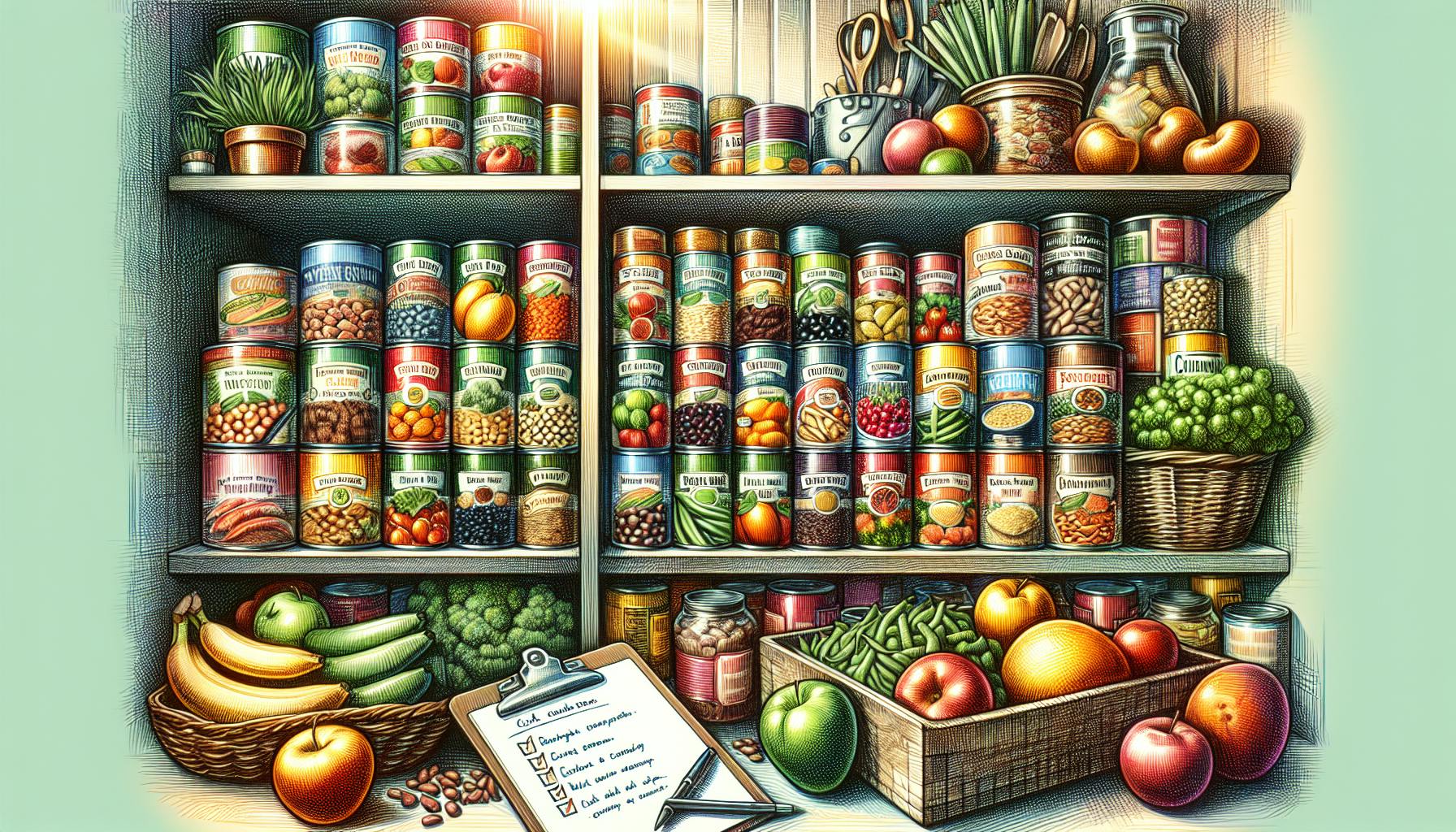Introduction to Canned Food Essentials for Emergency Kits
Having the right canned goods in an emergency kit is crucial for preparedness. Canned foods are ideal for survival situations since they have a long shelf life without refrigeration, are nutritionally dense, and provide comfort foods when needed most. The goal of this article is to explore the best canned food options to include in emergency kits. We'll cover the main categories of canned fruits and vegetables, proteins, meals, and other essentials. Stocking up on a variety of shelf-stable canned goods ensures you'll have nutrients and calories if the power goes out or if you need to evacuate.
Canned Fruits and Vegetables
Fruits and vegetables canned in juice or water provide important vitamins, minerals, and fiber. Great options include canned tomatoes, beans, pineapple, peas, carrots, beets, and mixed fruit medleys. Opt for low-sodium and canned-in-juice varieties whenever possible. Having a diverse assortment of canned produce ensures you get a range of nutrients in an emergency situation. Some top choices are diced tomatoes, kidney beans, mandarin oranges, peaches, pears, peas, carrots, and mixed veggies.
Canned Meats and Proteins
Getting enough protein from canned tuna, salmon, chicken, turkey, or beef is key to maintain energy and strength during an emergency. Choose lean, water-packed varieties of fish and seafood as well as unsalted meats. If opting for flavored tuna or chicken, read labels carefully and watch the sodium content. Make sure to rotate stock, using the oldest cans first. Shelf-stable proteins like chunk light tuna in water, salmon, canned chicken breast, Vienna sausages, and ready-to-eat spam are great options.
Canned Soups and Meals
Canned soups and meals like chili, ravioli, and beef stew provide calories, carbohydrates, and comfort. Look for lower-sodium varieties and meals that are shelf-stable versus needing water added. Ready-to-eat canned pasta, soup, and stew options are easy to heat and eat in tough times. Ideal choices include minestrone, vegetable beef, cream of mushroom or chicken soup, ravioli, and chili with beans.
Other Essential Canned Goods
Water, broths, coconut milk, and staple grains like rice and quinoa provide hydration and key nutrients. Oils like olive and coconut are also useful for cooking. Consider treats like coffee, tea, or canned sweets as well in moderation. Essentials like canned diced tomatoes, chicken and veggie broth, canned coconut milk, olive oil spray, rice, coffee, and canned peaches offer versatility.
Storing and Organizing Canned Goods
Properly storing canned goods in a cool, dry place helps maximize shelf life. Organize by type and expiry date, labeling cans or using a dispenser rack for easy rotation. Inspect periodically and watch for dents, swelling lids, and corrosion. Strategic storage techniques like under-bed containers and dispensers save space while keeping foods accessible in emergencies.
Key Nutritional Canned Foods for Emergency Situations
In an emergency, focus on high-protein, hydrating, and vitamin-rich canned goods. Canned fish like salmon provides omega-3 fatty acids for heart health. Meats like chicken breast add lean protein without much prep needed. Fruits and veggies prevent vitamin and mineral deficiencies. Beans and legumes offer protein, fiber, and versatility. Broths and coconut water help prevent potentially dangerous dehydration. Nutrient-dense picks include salmon, sardines, diced tomatoes, garbanzo beans, peaches in juice, carrot slices, chicken breast, vegetable broth, and coconut water.
Hydrating Canned Foods
Getting enough fluids is critical in emergency situations, making canned broths, coconut water, and fruits ideal. Chicken, beef, and vegetable broths provide essential electrolytes while being easy to consume. Canned coconut water offers a natural source of hydration with potassium benefits. Fruits packed in their own juices also provide hydration along with vitamins.
Fortified Canned Foods
Some brands like Eden Foods fortify canned foods with extra vitamins and minerals. In limited emergency diets, these added nutrients provide health benefits. However, check sodium levels as some fortified brands may be higher. Balancing fortified and regular canned goods gives you a nutritional boost. Spaghetti sauce, soups, tuna, salmon, beans, and veggies are commonly fortified.
Canned Fish High in Omega-3s
Fatty fish like salmon, sardines, and mackerel canned in water provide inflammation-reducing omega-3s. Compared to fresh, canned fish has less mercury concerns since smaller, younger fish are typically used. While tuna is certainly convenient, limit intake due to higher mercury levels. Canned salmon, mackerel, herring, and light tuna packed in water are all great options.
Canned Meats as Protein Sources
Canned chicken, turkey, and beef provide lean protein to keep energy levels up in tough times. Opt for unsalted or low-sodium varieties of canned meat and poultry when possible. While seasoned options add flavor, watch out for high sodium content in certain flavored canned meats. Always make sure to follow first-in-first-out practices as well. Shelf-stable picks like canned chicken breast, turkey breast or ham, corned beef hash, and low-sodium spam provide protein without much hassle.
Canned Beans and Legumes
Beans and lentils canned in water offer plant-based protein, fiber, and a range of vitamins and minerals. Rinsing beans after opening can help reduce added sodium. Beans make for versatile additions to soups, salads, sides, or entrees. Kidney, black, pinto, cannellini, and garbanzo beans along with lentils are all nutritious canned legumes to stock up on.
Specialized Canned Foods for Medical Conditions
Those with certain health conditions still require specialized diets even in emergency situations. Low-sodium foods are ideal for heart health. Verify gluten-free status for those with celiac disease. Infant formulas, allergy-friendly foods, and diabetic options also provide needed nutrients.
Low-Sodium Canned Foods
For those limiting sodium due to blood pressure or heart issues, low- or no-salt added canned goods are a must. Rinsing salted canned beans, using reduced-sodium stocks, and buying no-salt veggies are helpful strategies. Great options include no-salt added tomato sauce, low-sodium Progresso chicken broth, and rinsed canned beans.
Gluten-Free Canned Food Options
Plain fruits, veggies, beans, meats, and seafood are naturally gluten-free. However, check labels carefully for possible cross-contamination from shared equipment. Stick to basic, unseasoned varieties of canned meats, seafoods, beans, fruits and vegetables to be safe. Certified gluten-free products like Eden Foods canned beans are also great options.
Specialized Infant Formulas and Foods
Jarred purees, infant cereals, and formulas provide babies essential nutrition not found in adult canned foods. Allergy-friendly and sensitive stomach varieties also accommodate little ones' needs. Having extra infant supplies relieves stress on parents during already difficult times.
Canned Diabetic and Diet Foods
Those with diabetes or watching sugar intake can opt for lower-sugar fruits canned in juice rather than heavy syrup. Heart-healthy fish, vegetables, and unsalted stocks make nutritious, lower-calorie choices. However, with limited food availability, sufficient calories and nutrients take priority over restricting calories. Look for fruits in juice, unsalted vegetables, and fish packed without added oils.
Tips for Building a Well-Rounded Canned Food Supply
Take stock of your current emergency canned goods, checking expiration dates and noting any nutritional gaps. Aim for a wide variety of vegetables, fruits, beans, meats, broths, and grains on hand. Balance hydrating, high-calorie, and protein-packed foods to cover all nutritional needs. Limit excess sodium, sugars, and heavily processed ingredients when possible. Useful checklists help ensure you have 2-4 weeks' worth of a balanced mix on hand.
Storing Canned Foods Properly
Always store cans in a cool, dry place out of direct sunlight and extreme temperatures. Organize with oldest cans in front and group similar items. Consider under-bed bins, RV dispensers, and shelving to maximize space while keeping foods accessible. Take regular inventories and replenish opened or expired cans.
Safely Consuming Canned Foods
Carefully follow all instructions for safe heating and cooking. Never eat from cans that are dented, swollen, or corroded. Wash cans and hands before opening. Refrigerate and promptly use opened canned goods. Avoid cross-contaminating foods and thoroughly cook canned meats. Following basic food safety helps avoid illness from improperly handled canned foods.
Creative Ways to Use Canned Foods
Get creative with canned goods like making tuna casseroles, salmon cakes, bean soups, and chili. Flavor canned fish and meat in tacos, pasta, sandwiches. Use canned fruits in parfaits, smoothies, baked goods. Incorporate into everyday cooking now to become comfortable with using them in emergencies. The options are endless with a well-stocked pantry of canned foods!
Conclusion
Having the right canned goods on hand makes emergency preparation simple. Focus on nutrient-dense fruits, vegetables, proteins, meals, and staple items with long shelf lives. Properly store and rotate stock to maximize freshness. Get creative cooking with canned goods now, so you have the knowledge needed to make delicious meals in tough times. Use this guide to evaluate and build your own well-rounded canned food supply for your emergency kit. Being prepared with shelf-stable nutrition provides comfort and peace of mind for any situation that arises.


